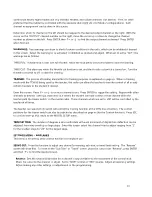
Sub-trim:
Finely
adjusts a channel's center position. Be aware that extreme adjustments of sub-trim could
possibly result in servo binding if the servo's output arm moves too far in the model. This is available for all
channels.
Travel limits:
Sets the maximum travel limits for each channel. Limits can be set for
each side
of center. If two
channels are mixed, adjusting the travel limits of
each individual channel
may be necessary to adjust the travel
limits for the entire mix. Move the cursor to the channel to adjust. Deflect the control stick for that channel to
one side and notice the cursor on-screen will move accordingly. Set the percent for that direction of travel as
needed. Move the stick to the opposite direction and repeat. Repeat for all channels as needed.
DUAL-RATES, EXPONENTIAL:
For setting dual-rates and/or exponential travel for the aileron, elevator, and
rudder channels. Dual-rates allows a channel's maximum travel limits to be switched between two limits.
Exponential changes the
rate
at which a servo rotates per degree of control stick deflection. The rate of servo
movement is non-linear in relation to the movement of the stick. The higher the exponential percentage, the
more the servo will rotate as the stick is moved away from center position.
To select the desired channel to adjust, press ENTER, then
↑
+ or
↓
- . Press ENTER when finished.
Assign a switch to change the dual-rate / exponential setting by moving the cursor to the CTRL line, and press
ENTER. Select the switch that will control this function as explained on page xx. Press ESC when finished.
Different dual rate and exponential settings can be set for each position of the switch. Highlight the dual-rate
percentage and move the assigned switch to the position that will allow for the furthest servo travel. Adjust this
percentage to the widest travel distance as needed for this channel. Note that the slope of the diagonal line in
the graph changes as the percent is adjusted. Deflect the control switch to the opposite position, and adjust the
percentage to the lowest travel distance needed. The diagonal line on-screen will now show the slope for the low
dual-rate setting. A low rate can allow for better control of the model while on the ground, at low altitudes, or
while performing certain maneuvers. A high rate can allow for optimum control of the aircraft in mid-flight.
To set an exponential value, move the cursor to the EXPO line and repeat the steps explained above to set a
different value for each position of the control switch. This function can be handy for optimum control of the
model - especially around center-stick position, and when performing stunts or aerobatic maneuvers.
Moving the control stick for the channel shown on-screen will change the position of the vertical line in the graph.
The point where the vertical line intersects the diagonal line is shown at the bottom-left on the screen. The "x"
(horizontal) coordinate is on the left, and "y" (vertical) coordinate is on the right.
Repeat the above steps for each the aileron, elevator, and rudder channels as desired.
CH5 AND CH6 SET:
Enter this screen to set the functions of channels 5 and 6. At the INPUT line select CH5 or
CH6. Then follow the steps below.
Control:
Choose which switch will control the selected channel. Switches are identified by letters A through H, as
printed on the transmitter next to each switch.
On-screen the switches will be identified as "SWA" for switch A, "SWH" for switch H, and so on.
All are 2-position
switches except switches "E" and "C" which have 3-positions. Deflect the switch which will ultimately control this
function.
12



























